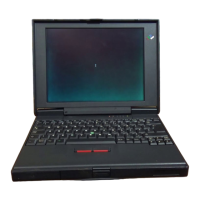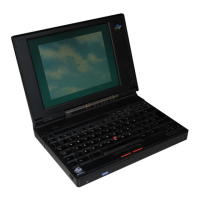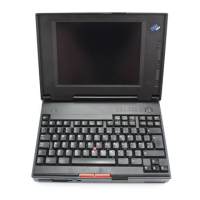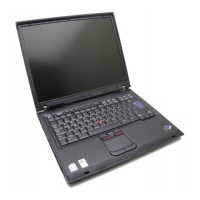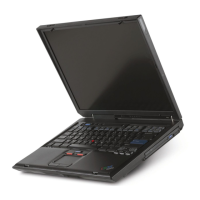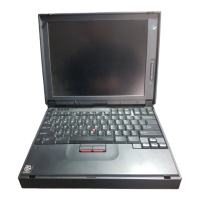
Do you have a question about the IBM ThinkPad 380 and is the answer not in the manual?
| Model | IBM ThinkPad 380 |
|---|---|
| Operating System | Windows 95 or Windows NT 4.0 |
| RAM | 32 MB (expandable to 80 MB) |
| Storage | 2.1 GB HDD |
| Display | 800x600 resolution |
| Graphics | 1 MB VRAM |
| Optical Drive | Optional CD-ROM |
| Ports | Serial, Parallel, VGA, Infrared, PS/2 |
| Weight | 3.1 kg |
| Battery | NiMH |
| Dimensions | 300 x 250 x 50 mm (11.8 x 9.8 x 2.0 inches) |
Provides a colorful and clear picture with 65,536 colors at 800x600 resolution.
Offers wireless serial communication via an infrared port.
A graphical interface to easily set various system parameters.
Software to extend battery life by reducing power usage.
Allows setting passwords or using locks to secure the computer.
Features two PC Card slots supporting 16-bit PC Cards.
A pointing device that allows control without lifting hands from the keyboard.
Uses Fn key combinations with function keys for quick feature access.
Compatible with Sound Blaster for audio features and entertainment.
General outline of initial computer setup steps.
Instructions for verifying all necessary items are included.
Step-by-step guide to assembling and starting the computer.
Guidance on next steps after initial computer setup.
Review of the computer's hardware features with diagrams.
Explanation of the computer's status indicators and their meanings.
Instructions on how to use the TrackPoint III pointing device.
Details on using Fn key combinations for operational features.
How to use the keyboard's numeric keypad function.
Precautions and guidelines for handling the computer safely.
Control program for configuring and customizing computer features.
Built-in system setup function for date, time, and configurations.
Controls the computer's startup sequence of drives.
Information on displaying computer output on LCD or external monitor.
Summary of how to connect an external monitor.
Details on SVGA video modes and resolutions.
Information on installing and using PC Cards.
Enables point-to-point communication with other infrared-equipped devices.
Details the computer's multimedia audio capabilities.
Instructions on how to charge the battery pack.
Step-by-step guide for replacing the battery pack.
How to check the battery pack's current status.
Displays battery-pack conditions like power mode and status.
Tips and methods to extend the battery pack's lifespan.
Configures software to reduce power consumption when idle.
Details built-in battery power-saving functions.
Puts the computer into a low-power state, stopping tasks.
Saves data to hard disk and turns power off to save maximum power.
Explains power-on and hard disk password protection.
Protects information stored on the hard disk drive.
Displays personal information on the password prompt screen.
Attaches a security system lock to prevent unauthorized removal.
Information on installing and removing cards from PC Card slots.
Step-by-step instructions for inserting a PC Card.
Instructions on how to safely remove a PC Card.
Guidance on upgrading computer memory with a DIMM.
Detailed steps for installing or removing a DIMM.
How to connect external input devices.
Instructions for connecting an external keyboard.
Lists preinstalled software and requirements for reinstallation.
Procedures for installing supported operating systems and drivers.
Installation procedures for Windows 95 and its device drivers.
Instructions for installing OS/2 Warp and ThinkPad drivers.
Installation procedures for DOS Version 7.0 and device drivers.
Installation procedures for Windows Version 3.11 and drivers.
Installation procedures for Windows NT and its device drivers.
Lists common issues and provides answers to frequent questions.
Basic steps to test the computer's functionality.
Guides for diagnosing and resolving specific hardware/software issues.
Troubleshooting steps for screen and power-on issues.
Solutions for miscellaneous computer problems.
Further troubleshooting steps when initial tests fail.
Specific troubleshooting for battery-related issues.
Solutions for issues related to external monitor display.
Troubleshooting steps for hibernation mode issues.
Solutions for problems with infrared communication.
Troubleshooting for input device issues.
Solutions for issues related to PC Cards.
Information and procedures for obtaining technical support and service.
Guidance on preventing conflicts between hardware and software resources.
Table summarizing available system resources and their defaults.
Advanced information for using PC Cards with Auto Configurator.
How to check and allocate PC Card resources to avoid conflicts.
Strategies to prevent and resolve PC Card resource conflicts.
Using Virtual Card Services for DOS objects in OS/2.
Rules and guidelines for entering PS2 commands.
Overview of the computer's key features and capabilities.
Technical details including size, weight, environment, and electrical.
Information on power cords available for different countries.
Important safety precautions regarding electrical connections.
Standards for 3.5-inch diskettes for optimal performance.
Details the terms and conditions of the limited warranty.
Procedures and contact information for obtaining technical support and service.
General warranty terms, limitations, and legal notices.
Important notices regarding IBM products and services.
Lists trademarks associated with IBM and other companies.
FCC statement regarding digital device emissions.


